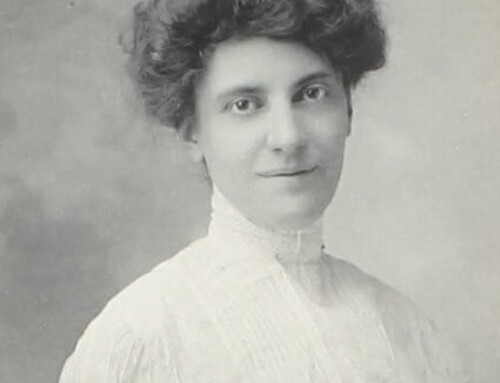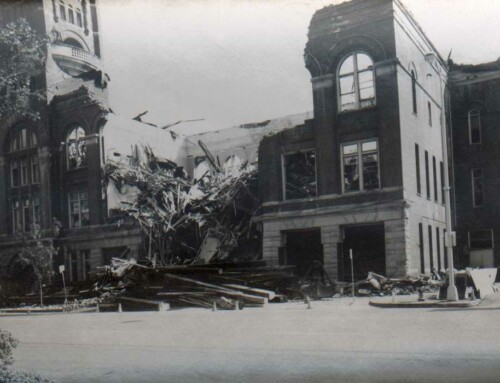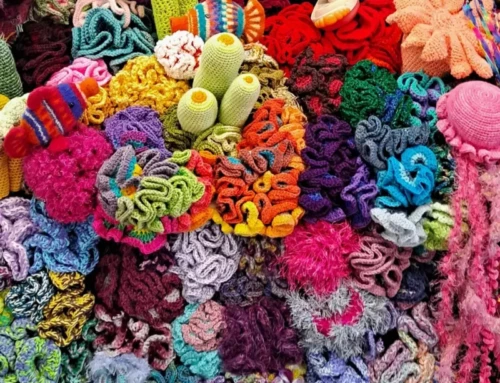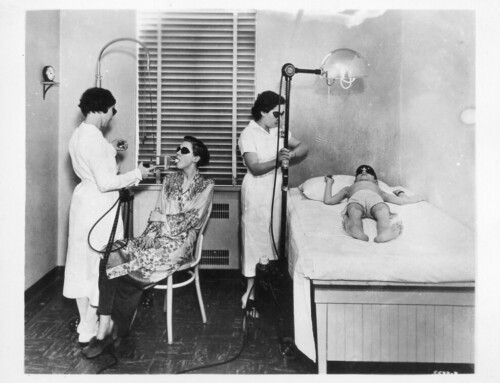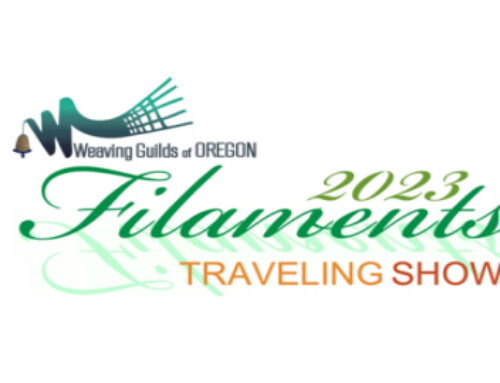In 1867, members of Edward E. Dodge’s Salem “Town Nine” challenged the Salem “College Lads” to a game of baseball where the Marion County Courthouse stands today. From this fateful game, a new fusion of sports and community took shape as people from all backgrounds from the Willamette Valley participated in America’s National Pastime. These participants included professional baseball players, college students of both genders, Native Americans, tradesmen such as lumbermen, and even convicts. Boys of Summer is designed to tell the stories of Mid-Valley communities and their devotion to baseball.
Journey back through time to the true inception of baseball, which predates the founding of our nation and is obscured by a great nationalist myth developed by baseball magnate and sporting goods mogul Albert Goodwill Spalding. Explore the evolution of various leagues whereby communities from Marion, Polk, Yamhill, Linn and Benton Counties reached out and connected with each other in the common bonds of baseball. Learn about the life and careers of the Mid-Valley’s greatest players and their contributions to the game both locally and on the national scale.
Boys of Summer is designed to illuminate stories that are beyond the scope of conventional sports history to showcase the life and times of the players, teams and communities that made the Mid-Willamette Valley a wealth of baseball talent and culture for the rest of the country.
Gregory J.K. Garcia, Jr., Guest Curator
This exhibit was featured at the Willamette Heritage Center in the Summer of 2014. It is reproduced here in an abridged form.
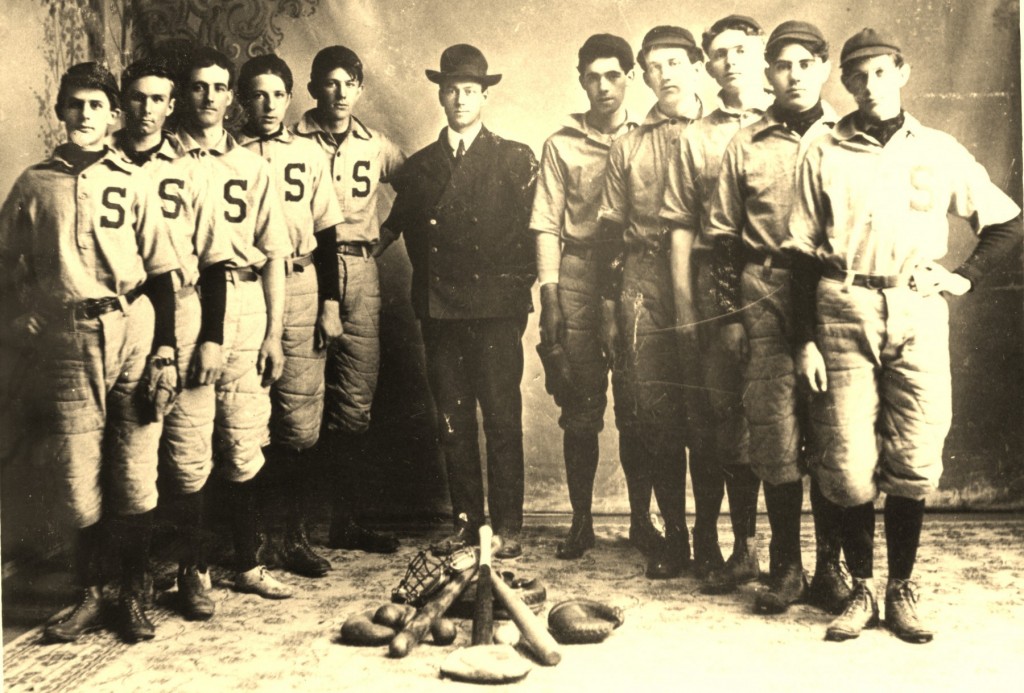
Boys of Summer: Baseball in the Mid-Willamette Valley
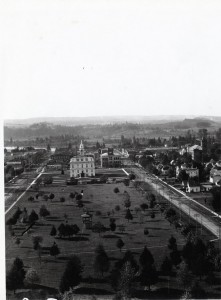
Site of First Organized Game
This photograph shows the view from the top of the Capitol building looking west in 1900. It shows the open area just behind the courthouse (in the foreground of this photo) where the first documented baseball game was held. Although much has changed, at least one landmark remains. Can you find the Grand Theatre building?
Photo Source: Willamette Heritage Center, Al Jones Collection, 2004.010.0646
Baseball Comes to the Mid-Valley, 1867
The first documented, organized baseball match was held between the Pacific Club “town nine” team, organized by Ed Dodge, and an informal group from Willamette University known as the “college nine.” The game was played on a field just east of where the Marion County Courthouse stands today. Although the Pacific Club won that contest, the Willamette University team became dominant and was called the “Salem nine.”
A Rivalry is Born
In the summer of 1867, the Salem Nine formally challenged the Pioneer Club of Portland to a game at the State Fairgrounds. During the two-hour game, the Portland team routed the Salem Nine, with Salem’s only pitcher breaking his collar bone in the first inning after being hit by a ball. The game ended with a final score of 92 to 25 and started a long-term rivalry between the two teams inflamed by frequent battles in the press. The lack of protective equipment in early games led to both poorer fielding and higher scores.
Oregon State Fair Tournament, 1873-1897
1873 marked the first of many baseball tournaments held at the Oregon State Fair. The first year, four teams competed for a first place prize of $100 and a second place prize of $25. The prizes had been increased to cover the $15 entrance fee assessed by the Agricultural Society that ran the fair. The State Fair baseball tournament continued to flourish into the late 1890s, successfully weathering the economic downturn of 1893 which had crippled organized baseball and the rest of the American economy.
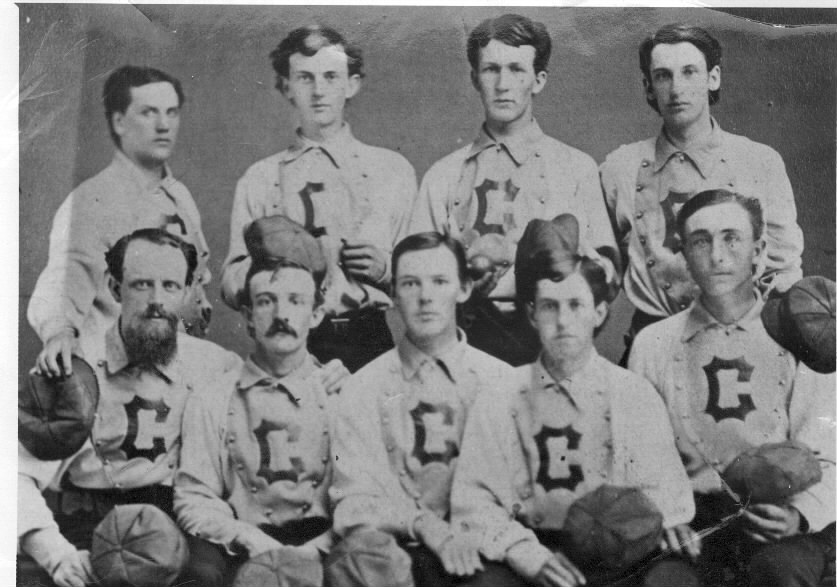
Salem College Baseball Team, 1872
This was the team representing Willamette University. Pictured are in the front row: Prof. John Garrison, George Richards, James McCully, Bliss Rickey and Oscar Taylor. In the back row: James Coleman, Preston Smith, George Belt and John Forsythe.
Photo Source: Willamette Heritage Center, 2007.001.0160
19th Century Trash Talk
An example of the types of accusations made by opposing teams can be found in this Oregon Statesman article (published November 1, 1873) in which the College Baseball Club claims:
Thompson’s colt that swam the river to get a drink has heretofore enjoyed the reputation having done the most foolish thing on record, but alas for the reputation of that colt the Pioneers claim the championship of the State, when in three games played between them and the College Club the score shows the latter the winner in two matches, and gives them a total majority of forty one runs over the Pioneers; now which is the most ridiculous, that colt or the Pioneers in claiming the Championship in the face of this record?
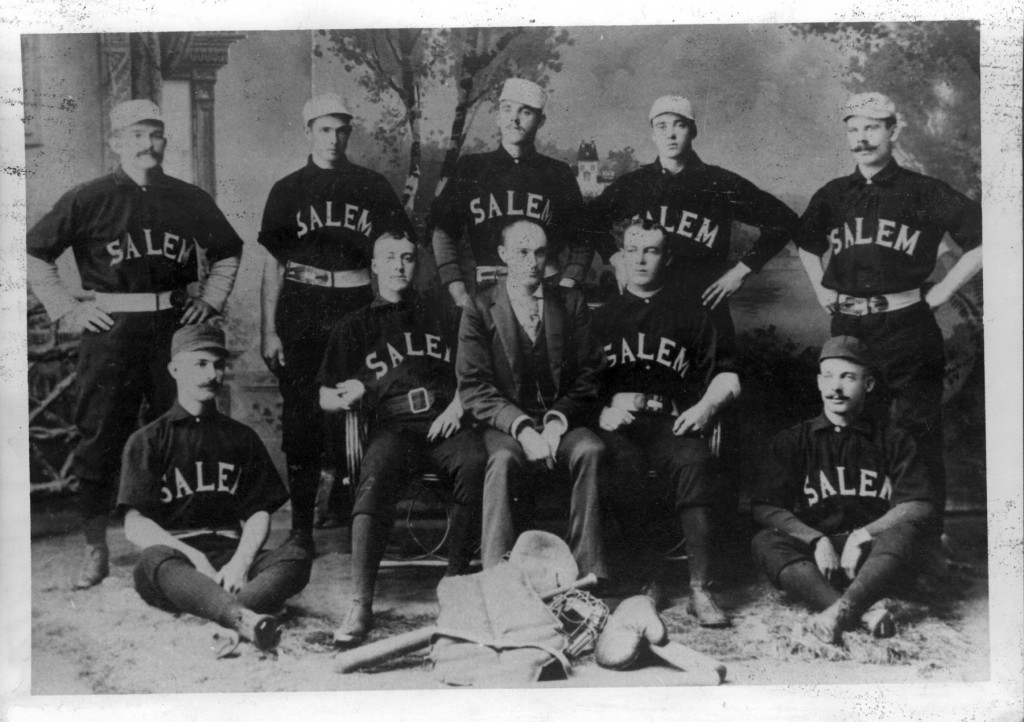
Salem Baseball Team, 1891
Front: Jay Smith, Joe Laueque, Douglas Minto (manager), Matt Stanley, Josh Riley
Back: Al Collette, Sam Booth, Cliff Mellon, Billy Lavan, Frank Cross.
Photo Source: Willamette Heritage Center, Al Jones Collection, 2007.001.0227
First State League, 1893
While many traveling professional and semi-professional teams existed in Oregon as early as 1891, they did not come together to form a league until 1893. The Willamette Valley Division of this league consisted of teams from Albany, Oregon City, Portland, and Salem. Independence was eventually added. Unfortunately, a nationwide economic crisis cut short the league’s life and it collapsed by the end of the year.
Developing America’s National Pastime
The earliest incarnations of baseball can be traced back to colonial America during the 1750s. The modern game of baseball is thought to be the result of the fusion of three sports: the British games of Cricket and Rounders and the American game of Barn Ball.
Barn Ball
This game originally consisted of two players, a bat, a ball, and a barn. The object of Barn Ball is to have the player hitting the ball (known as the “batsman”) hit the ball clear of the opponent (known was the “thower”), run to the barn designated as the “base” and return without being forcibly hit by the ball. Successfully accomplishing this feat meant the batsman was awarded a “run.” Eventually more “bases” and players were added, leading to the evolution of a sport commonly known as “One,” “Two,” “Three,” or “Four” “Old Cat” depending on the number of bases.
Remnants of Cricket
Baseball received a legacy of etiquette and dress from the English game of cricket. Cricket has strict guidelines governing all aspects of the game. If a player’s attire or conduct was not up to these standards, he was “not cricket” and asked to change or leave the game.
Knickerbockers
In 1845, a group of men who regularly met at the corner of Madison Avenue and 27th Ave in New York to play baseball decided to set down official rules for the sport. Known as the Knickerbockers for their stylish knee-length pants, their formalized rules were known as the “New York Game.” They limited the number of players to nine, standardized the playing field and allowed for games to continue as long as necessary for a team to reach a score of 21.
Founding Myth?
In response to claims that baseball was not a purely American game, sporting goods tycoon A.G. Spalding put together a commission to discover the “real” roots of baseball. His “Mills Commission” determined that Civil War General Abner Doubleday had invented baseball in 1839 in Cooperstown based on a tip from a supposed eyewitness. Although baseball historians have debunked this myth, it was pervasive enough to locate the National Baseball Hall of Fame in Cooperstown in 1939. On June 23, 1953, the United States Congress officially recognized former Knickerbocker Alexander Joy Cartwright, Jr. as the official inventor of baseball.
National Association of Baseball Players (NABP), 1857-1871
The NABP was the first official governing body for the sport of baseball. It pioneered many modern rules and regulations, which included painting foul lines and instituting umpires in games. In 1859, it even barred players from accepting payment for their services. However, many teams got around this ban by offering their players jobs, unrelated to baseball. Eventually so many teams blatantly ignored the rules that the ban became unenforceable, which led to the downfall of the NABP.
The National League, 1876
The National League was the first major league organization to be formed. The constitution for the National League was drafted in 1876, and many of its stipulations remain relatively unchanged today. Under its guidelines, any town with a minimum population of 75,000 could have a baseball club provided it could pay the $100 franchise fee. The National League started with eight teams in two divisions.
The American League, 1901
The American League came into existence in 1901. It also started with eight charter franchises.
- Baltimore Orioles
- Boston Americans
- Chicago White Stockings
- Cleveland Bluebirds
- Detroit Tigers
- Milwaukee Brewers
- Philadelphia Athletics
- Washington Senators
Only one of these original franchises still has its same name and location.
Can you name any of the original NL teams?
Check yourself!
East
Philadelphia Athletics (Disbanded)
Boston Redstockings (Became Atlanta Braves)
Hartford Dark Blues (Disbanded)
Mutual of New York (Disbanded)
West
Chicago Whitestockings (Became Chicago Cubs)
St. Louis Brownstockings (Disbanded)
Cinncinatti Redstockings (Disbanded)
Louisville Grays (Disbanded)
Which of the original AL franchises still has its same name and location?
The Answer is the Detroit Tigers
Of the original eight AL Franchises…
• Baltimore Orioles » New York Yankees in 1913 after a brief stint as the New York Highlanders
• Boston Americans » Boston Redsox
• Chicago White Stockings » Chicago White Sox
• Cleveland Bluebirds » Cleveland Indians
• Milwaukie Brewers » Became the St. Louis Browns in 1902 and the Baltimore Orioles in 1954
• Philadelphia Athletics » Kansas City Athletics in 1955 and the Oakland Athletics in 1968
• Washington Senators » Minnesota Twins in 1961
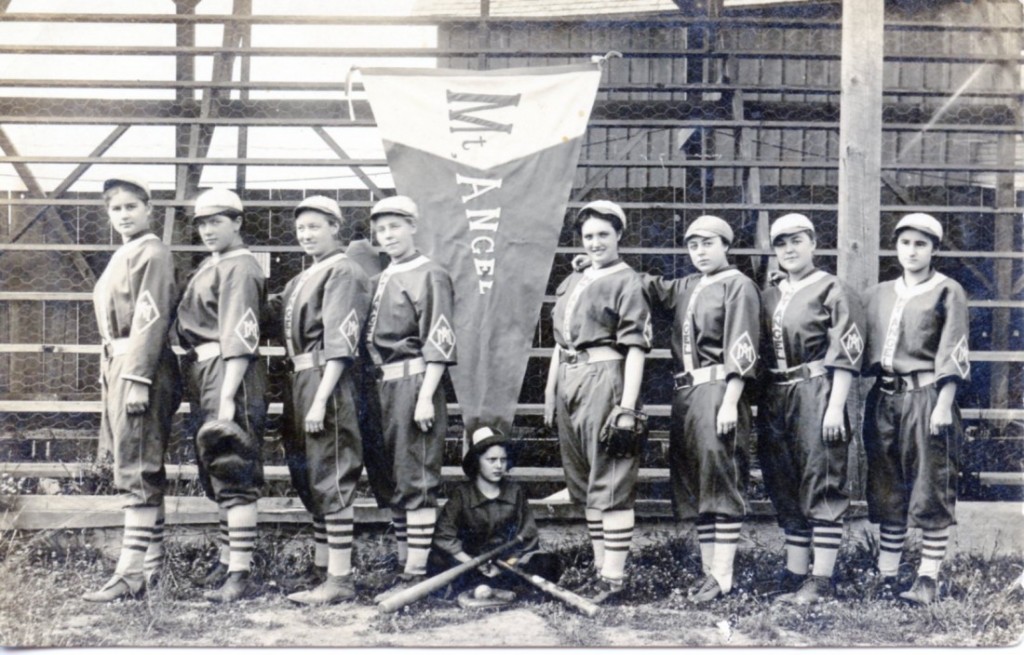
Mt. Angel Girl’s Baseball Team, 1912. WHC Collections 2007.003.0021.
Women’s Clubs and Bloomer Girls
Women’s baseball clubs began to appear as early as 1866. Named for their loose trousers designed by Amelia Bloomer, Bloomer Girls teams toured the country challenging male amateur and professional teams. The Boston Bloomer Girls played exhibition games at the Oregon State Fair in 1897, challenging local teams like the Chemawa Indian School and the Scio-Jefferson Baseball Club.
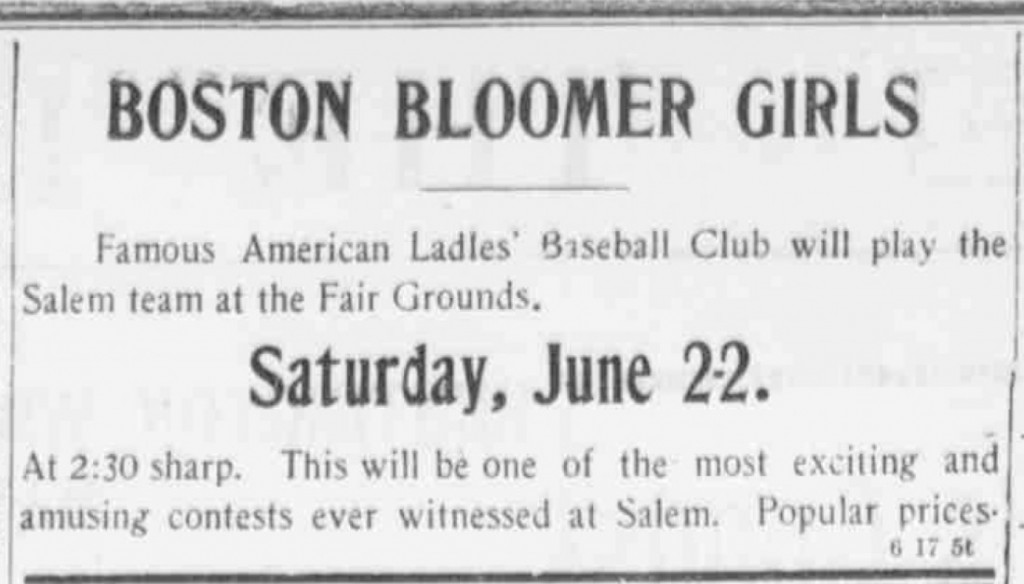
Advertisement for exhibition game of the Boston Bloomers Club at the Oregon State Fairgrounds, 1905.
Chemawa
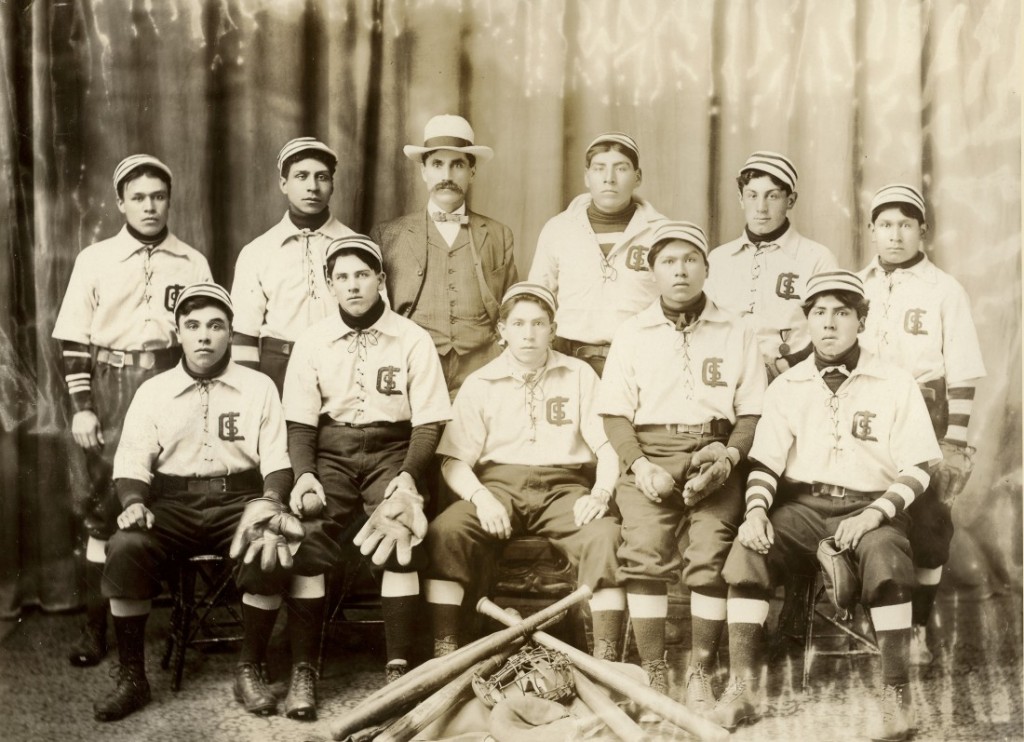
Chemawa School Team. WHC Collections 1998.001.0009.
The baseball program at Chemawa Indian Training School started in 1892. While students at Chemawa were high school aged, they went up against college and adult teams. There is documentation of them playing against the Multnomah Area Athletic Club of Portland, the Orions of Vancouver, Salem High School, Oregon State University, Willamette University, and the early incarnations of the Salem Senators team.
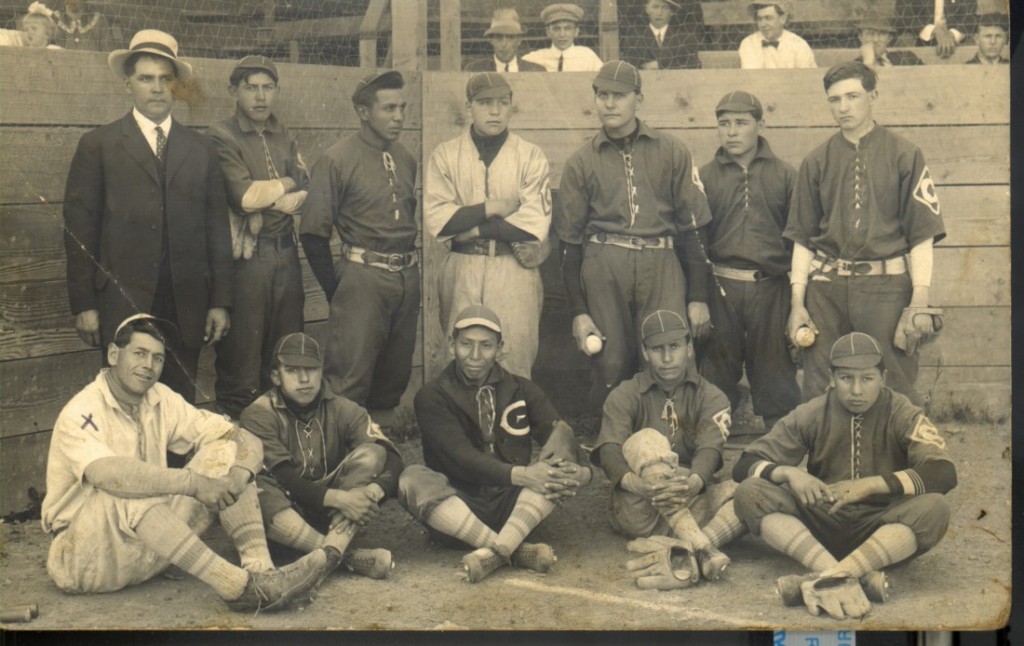
Chemawa School team, 1912. Rube Sanders seated on ground at far left in image. WHC Collections 1998.001.0026.
Reuben C. Sanders
You can read more about Sanders in this Oregon Encyclopedia article by David Lewis.
Reuben C. Sanders was an extremely gifted, multi-sport athlete. His baseball career spanned his time at Chemawa Indian School in Salem (where he played and coached) and a stint on the semi-professional Salem Raglands team. In 1972, he was inducted into the initial class of the American Indian Athletic Hall of Fame.
Amateur Successes
After economic depression killed efforts for semi-professional baseball in the Mid-Willamette Valley in 1893, amateur leagues flourished. Many teams were founded by different professions, or pre-existing clubs. This period saw contests between the Salem bartenders and the Salem tonsorial artists and Woodmen of the World versus the Ancient Order of United Workman.
The Salem Senators, 1907-1939
The first incarnation of the Salem Senators was a semi-professional team that started around 1907, and won the Tri-City League championship for two consecutive years. The Senators played many teams on various levels, including college and high school teams.
Baseball as Therapy
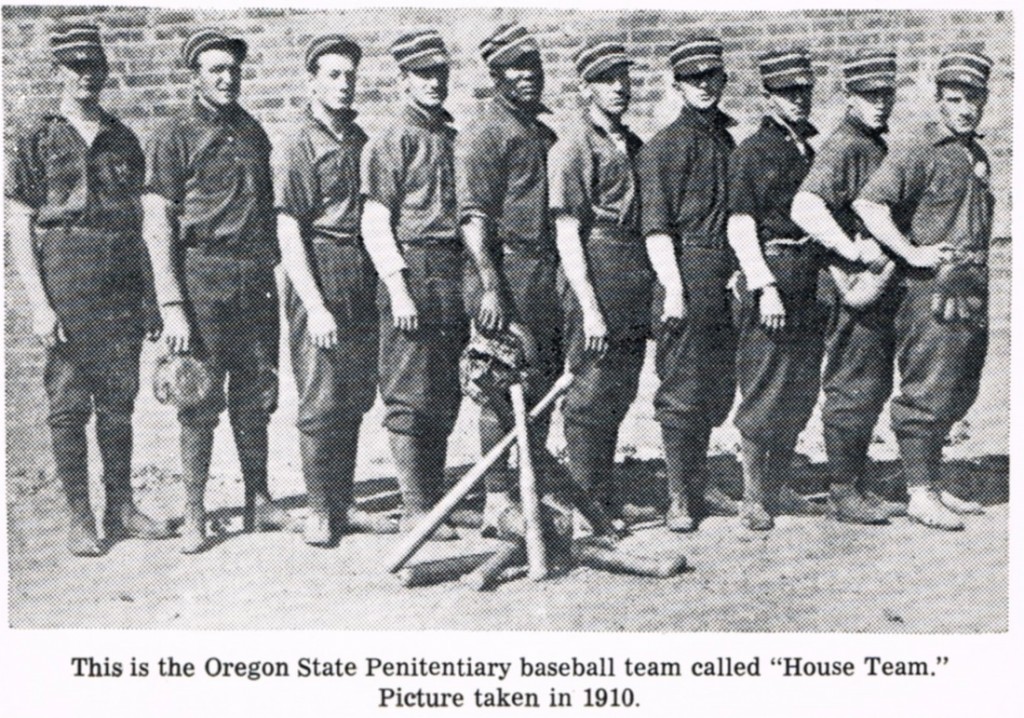
WHC Collecitons, 1984.025.0001.026
Baseball was used as a therapeutic tool and an incentive for good behavior at Oregon’s State Institutions. The Oregon State Penitentiary and the Oregon State Hospital both had teams.
Memories of a Patient, 1936
Right now we spend quite a lot of time talking about baseball. We hash over our won ball game that is held every afternoon and discuss the major league teams and how Portland is doing in the Coast League. You’ve probably never seen a baseball game quite like the ones we play here. Play is stopped for heated arguments much more frequently than even in the hottest contests between regular teams. Usually the arguments center about the subject of why several players are allowed on the field, casting aspersions at their capabilities as baseball players. In other words we think they’re crazy and tell them so.
Source: James R. Robblett (pseudynom for patient at the Oregon State Hospital) as told to Paul Hauser and Oregonian, 1936.
Capital City Amateur League, 1906
Some amateur play was organized beyond challenges between groups. In 1906, W.T. Perkins create the Capital City Amateur league which had seven Salem-based teams including the Bankers, Bookkeepers, Capitols, Grocers, Merchants, Statesman and the Woolen Mills.
See the Stuff. Click on a Tab below to explore items from the WHC’s Collections.
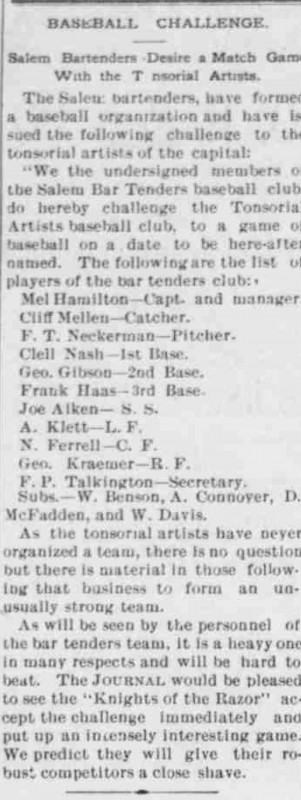
Challenge issued in newspaper, published May 13, 1897 in the Capital Journal.
The Challenge
Amateur baseball teams in the area often challenged a rival through the newspaper. Challenges typically listed player lineup and date and time of the match.
Quoted Text: Salem Bartenders Desire a Match Game with the Tonsorial Artists. The Salem bartenders have formed a baseball organization and have issued the following challenge to the tonsorial artists of the capital: “We the undersigned members of the Salem Bar Tenders baseball club do hereby challenge the Tonsorial Artists baseball club, to a game of baseball on a date to be hereafter named. The following arethe list of players of the bar tenders club:
Mel Hamilton – Capt. and Manager
Cliff Mellen — Catcher
F.T. Neckerman — Pitcher
Clell Nash — First Base
Geo. Gibson — 2nd Base.
Frank Haas — 3rd Base.
Joe Aiken — S.S.
A. Klett– L.F.
Nell Ferrell – C.F.
George Kraemer — R.F.
F.P. Talkington — Secretary
…
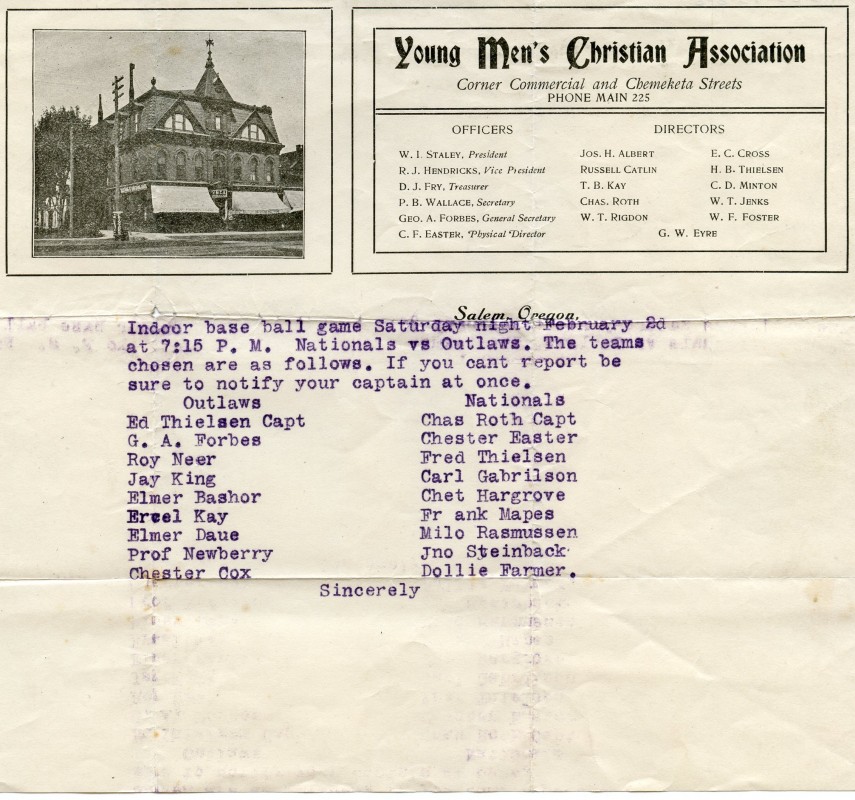
YMCA Indoor Baseball Game program. WHC Collections 0083.043.0006.006.
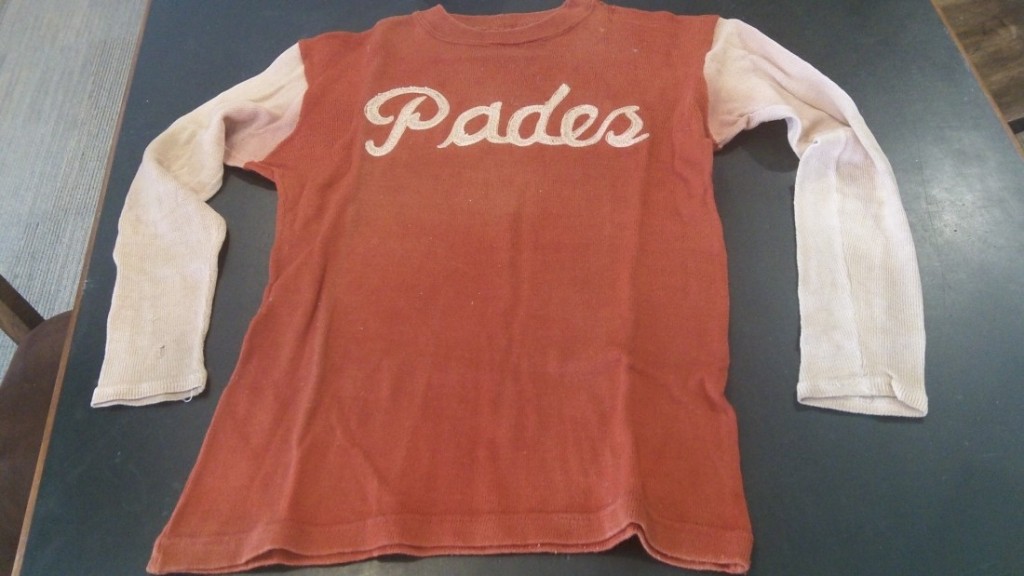
Technically a softball jersey, this was worn by Elmore Hill in the 1934 Oregon State Softball Championship. Pades’ was grocery store on State Street in Salem. WHC Collections 2004.026.0032.
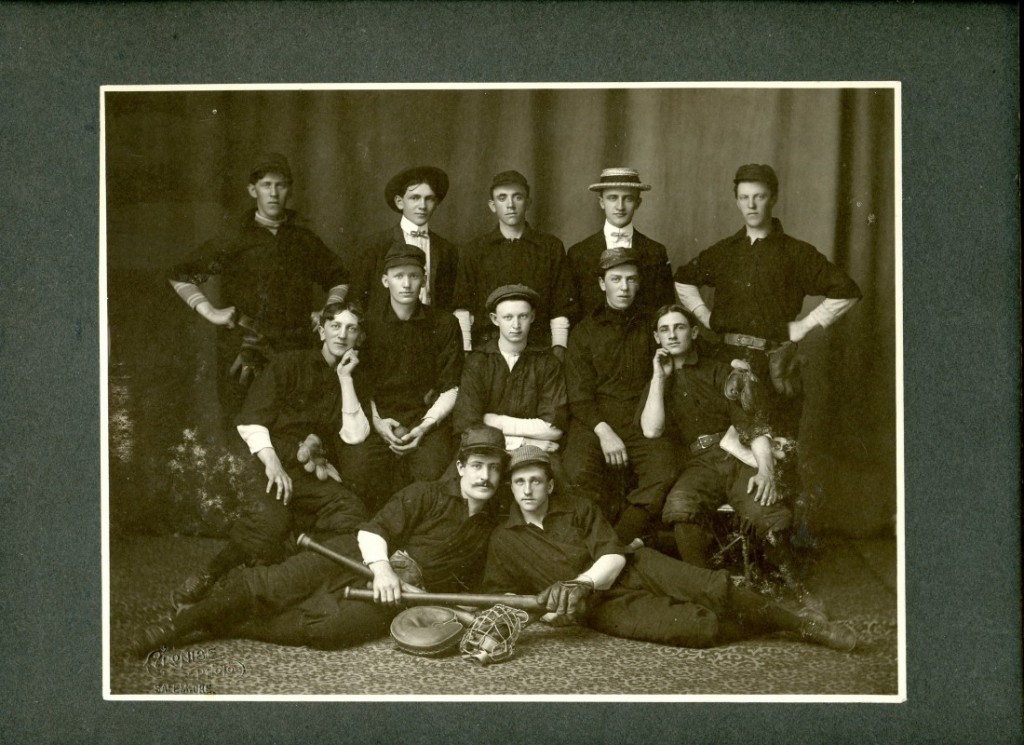
Thomas Kay Woolen Mill Baseball Team, Salem, Oregon, June 26, 1904. WHC 0082.021.0001
Salem’s Team
The Salem Senators, 1907-1939
The first incarnation of the Salem Senators was a semi-professional team that started around 1907, and won the Tri-City League championship for two consecutive years. The Senators played many teams on various levels, including college and high school teams.
The Senators Evolve, 1940-1960
Salem tobacco merchant George E. Waters purchased the Bellingham Chinooks and moved them to Salem. This second incarnation of the Senators teams started out as an unaffiliated Class-B Minor league team in the Western International League. Waters would not live through the first season of the team he had brought to Salem.
Local Incentives
Unaffiliated minor league players were not paid well. Local businesses picked up some of the slack with promotional incentives. Valley Packing offered a free smoked ham for every home run hit, delivered directly to home plate as the runner returned. Player Mel ‘Ham Bone’ Walsey, took advantage of this promotion, bringing a ham home about 25 times a season.
Local Team
A slump in the 1949-1950 seasons led the Beavers to try and move the Senators. Local citizens led a movement to buy back the team and keep it in Salem. They sold stock and raised funds to purchase the team for $50,000.
Beavers Farm Team, 1946-1950
As part of the Pacific Coast League, the Beavers had great aspirations of becoming a Major League team. They acquired the Salem Senators from Mrs. Waters in 1946, to serve as a farm team.
Salem Dodgers, 1961-1965
Shortly after the Brooklyn Dodgers moved to LA in 1958, the Salem Senators became a farm team affiliate. The team even took on the name Salem Dodgers. Lack of funds and interest led to the collapse of the team in 1965.
Senators Return, Again, 1977-1981
After a 10 year drought, local stock broker Clint Holland brought professional baseball back to Salem in 1977. The team played its home games at Chemeketa Community College.
Angels, 1982-1987
The reborn Salem Senators would affiliate with the Angles in 1981. The team went on to win the Northwest League championship in 1982. The young Angels team had a 34-36 record, and beat the 53-17 Medford A’s in the Championship Game. The win is considered one of the biggest upsets in minor league history.
Return of the Dodgers, 1988-1989
In the two short years the Salem team was known as the Dodgers, they featured 6 players that would go on to become major leaguers – Mike Piazza, Hector Ortiz, Henry Rodriquez, Braulio Castillo, Tony Barron and Rafael Bournigal. The Dodgers folded in 1989 due to being unable create a proper facility in the Salem Area and were moved to Yakima where they became the Yakima Bears. The team was moved again in 2012 to Hillsboro, where they became the Hillsboro Hops and regularly play against Salem’s new team, the Volcanoes.



